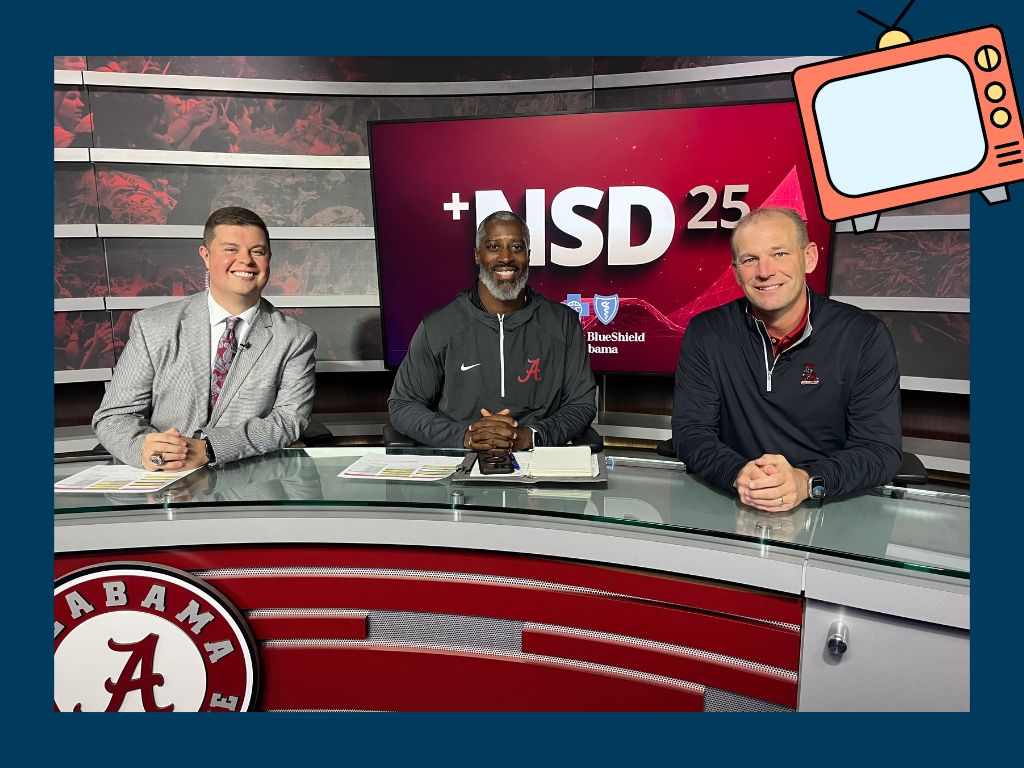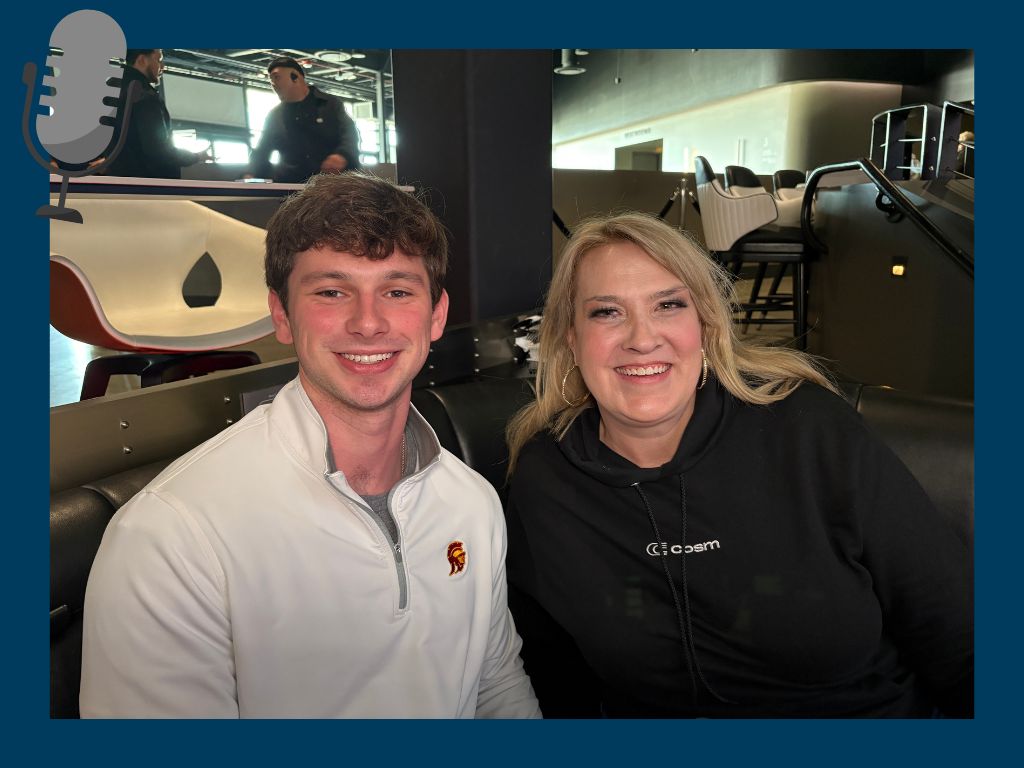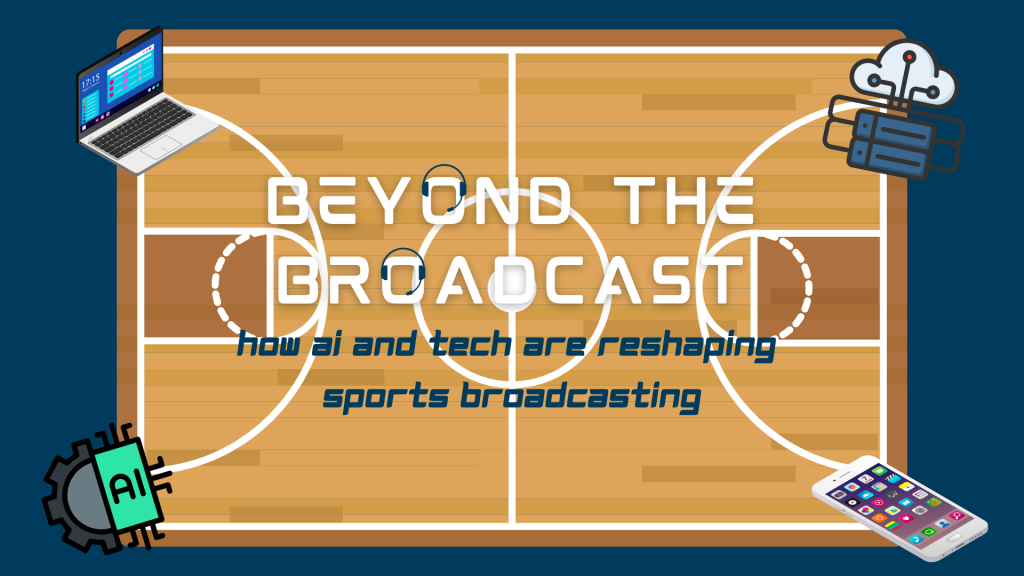As the clock hits triple zeroes in the fourth quarter, the USC Trojans capture another win and the night comes to a close. There will be celebrations, smiles and plenty of momentum heading into the weekend, ready to face another opponent. For Trojan Coach Lindsay Gottlieb and company, the attention turns to the next opponent, as the team gets ready to extend its win streak. The Trojans will break down film, learn about opposing players and understand what it takes to win the next game.
Sitting court side, Eli Kleinmann, one of the youngest broadcasters in college athletics, takes off his headset, folds up his manila folder and laptop, tucks them into his backpack, pops a cough drop into his mouth and drives back to Culver City.
While he’s not draining threes or scribbling on the whiteboard, Kleinmann experiences the same daily drills as the Women of Troy. The Voice of USC Women’s Basketball will get a good night’s sleep before waking up and turning his attention to the next opponent. As a play-by-play broadcaster, Kleinmann doesn’t just show up to Galen Center each night to call a two-hour contest, but puts in hours upon hours to ensure he can deliver the best story on air, learning the ins and outs of each opponent and what each player brings to the table. As he sits down at his desk the following morning, he opens his laptop, heads to the opposing team’s website and begins to scout them out.
“Preparation is everything in this job. If you’re not ready, the audience can tell in the first thirty seconds,” Kleinmann said. “It’s about doing the homework so that when the game starts, you can just tell the story.”

But in 2025, Kleinmann doesn’t need to stress himself out hunting the internet for stats and storylines as much as he would’ve in the mid-2010s. He opens Perplexity, an AI engine, and prompts it with specific questions about players. While it may seem like a wild idea, the innovative broadcaster sees plenty of benefits.
“AI is becoming something that, if you know how to utilize it, certainly can be an advantage for broadcasters.”
With an abundance of information on the internet, it could take hours for USC’s Voice to not only find information on one player but also choose the right nuggets. Having this in mind, he tells Perplexity exactly what he wants to know: a combination of the player’s overview, quotes from coaches and personal anecdotes that reveal the athlete’s true self.
“There’s so much information on the internet,” Kleinmann said. “The ability to use AI to be able to dive through it and really pick the type of stories and information you want without having to search through everything yourself makes things a lot easier.”
Like many AI engines, Perplexity takes the user’s prompt and searches the internet to find specific information. When Perplexity finishes searching the internet, it not only gives you a summary of the information, but includes links for the sites it found the information on. Kleinmann considers this a huge benefit because it allows him to both fact check Perplexity, but also read deeper into a specific article that it found in seconds that might’ve taken him five minutes to find himself while scouring through the internet.
In an industry where preparation and performance are everything, AI and technology are reshaping the sports broadcasting landscape—streamlining research, enhancing storytelling, and giving broadcasters like Eli Kleinmann a powerful new playbook to work from. As they evolve, so does the way those behind the mic and camera prepare, perform and connect with their audiences.
While AI is a key component and a normal thing to the 23-year-old broadcaster, he is one of few voices to have reaped its benefits early in his career. Even for a polished broadcaster in his thirties, Roger Hoover recognizes how AI’s recent emergence is a new thing to the industry and something he is still learning about.

“I’m still somebody that puts together my spotting boards by hand, not really automated or anything like that,” said the radio voice at the University of Alabama. “I’m still getting everything organized in the way that I’m kind of used to.”
While Hoover prefers his style of preparation, which has spanned since he first donned the headset in 2006 as a student at the University of Tennessee, he recognizes how far technology has taken the industry.
“If not for the initial technology we had in the 1910s and the ‘20s and the ‘30s to get us to where we were putting games on radio, there would be none of this industry that there is today.”
Sports broadcasting first began as a radio-only medium. Families in New York City would huddle around their fireplaces, plop a large hand radio on the ground and turn the dial to find the New York Yankees game, cheering on their team from the comfort of their own home.
Flash forward nearly a century later, fans can walk around Central Park, pull out their phones and find the Yankees’ Voice Michael Kay on YES Network to watch Aaron Judge and company take the diamond for the Bronx Bombers. Hoover admires how technology has advanced broadcasts, especially with the rise of streaming.
“It really goes hand in hand when you think about how technology has moved sports forward,” he said. “All in all, it’s a huge part of what we do, and I think using the latest technology is really important to continue finding new ways to connect fans to the games they really wish they were at.”
Hoover recalled his days as a student back in Knoxville and chuckled when speaking about the technology at hand. One camera, no updated stats and a small blurry screen for viewing which he said it was nearly impossible to make out which players were on the screen.
“It kind of looked like ants marching around,” Hoover said as he laughed. “The technology was terrible.”
While he as a broadcaster struggled to make out the action at times, so did the fans back home. Those fuzzy screens and one angle made it a challenge to understand the entire game. As a play-by-play broadcaster, the primary objective is to tell a story, relaying information to the audience, whether it be the story of the game or the story of a specific player.
Explore How Tech and AI Impact a Student Radio Broadcast
Outside of play-by-play broadcasters experiencing next-level technology, the behind-the-scenes broadcasters in the production room are reaping the same benefits. Ryan Cole, the Vice President of Video Technology at Cosm, believes storytelling is the most important piece of the puzzle of a broadcast, even for the cameras.
“They’re responsible for delivering the best show possible,” he said. “They need to tell a story. They’re not just following the action.”
In a new generational viewing experience, Cosm allows fans to feel that they are at the game without paying an absurd amount of money for a ticket. Through its immersive camera angles, the company showcases games in an iMax-like theatre, with camera angles on the sideline or court side for action, just like you would be watching from the stadium.
Cosm started in the planetarium industry over 75 years ago, using its technology to help bring outer space to life, but it slowly began to bleed into other areas such as theme parks, such as Disney’s Soarin’ Over California. About four and a half years ago, Cosm decided to take the leap into sports entertainment. At first, Cosm was doing live VR for big events, like the Super Bowl and the World Cup. But it still wanted to dive into the broadcasting industry.
Cosm acquired a company called C360, which focused on immersive camera angles and adding splashes to broadcasts to not only enhance the on-the-field product, but help tell the story at home. It partnered with the bigwigs, such as ESPN, Fox and CBS to implement these angles into their broadcasts. The pylon camera became revolutionary for football, the bunker camera for golf and even a camera on the top of the backboard for basketball. Cole recognizes what Cosm does is revolutionary in its storytelling yet also aids the broadcasters, which led to a real rise in broadcast production.
“We think that some of our stuff really got channeled by some of those broadcasters to say, ‘Hey, look, this is something unique. It’s not something we’ve had before. Let’s give it a shot.’”

Cole sees the biggest benefit in groundbreaking technology for the fans at home. He alluded to the frustration a fan might experience when hearing about something on TV but not see it. He says now, with so many camera angles, the full story of the game is able to not only be told, but shown.
“We can show you if you missed a certain play call, or if someone broke the line to gain or if someone scored a touchdown,” Cole said. “Those are the kinds of things that you wouldn’t really be able to get on a normal, traditional camera angle.”
He continued with how it elevates the broadcast.
“We think there’s a lot of really unique ways to take our camera systems and our technology and put it into the hands of the leagues and the broadcasters to really tell a different story and help elevate the story that’s there.”
Technology and AI have most certainly enhanced the sports broadcasting industry, but there is fear that it could rapidly change the industry, possibly killing certain jobs and even entire mediums. Recently, tennis experimented with AI broadcasters for lower-level matches. It didn’t take human jobs, as no broadcasters were assigned to the match. However, it did open a pathway many in the industry fear: AI doing its job, leaving them jobless.
In 2024, Wimbledon and the U.S. Open both used AI broadcasters powered by IBM, which accumulated next-generation stats, such as ball speed, swing speed and simply deciphering forehand versus backhand shots. Even at smaller levels, AI has been used for voice acting, using text-to-speech for cost efficiency, which has been successful in multiple areas. Carlo Jimenez, the radio broadcaster for the Los Angeles Clippers and also the youngest voice in the NBA, recognizes that this may one day be a possibility.

“I would be a little concerned that there could be AI broadcasters that get so good that you wouldn’t know,” Jimenez said. “AI learns at such a fast speed.”
While expressing some concern, Jimenez, among others, believes play-by-play broadcasting may be too complex for AI to do the job extremely well.
“Broadcasting in some ways is sort of an art form,” he said. “You have all this information and then you’re trying to find the right words to describe what just happened. So it’s not something that’s repeatable necessarily.”
Outside of his belief that AI won’t be able to do the job at the same level a human can, he believes fans will lose the humanistic connection to their favorite broadcaster. Jimenez says that’s one of the main things that got him into broadcasting.
“I know in my own experience as a fan, whenever I hear the voices of somebody like John Miller or Dave Fleming who I grew up listening to on Giants Radio, I perk up.”
Personal connection is one of Jimenez’s greatest strengths, and he has technology to thank. Beginning as a junior at USC, the young broadcaster wanted to grow his brand, so he started posting daily on TikTok. He posted videos of highlight calls, showing fans the action along with his reaction, as well as his day in the life as a broadcaster. His following started with just friends and family, but as he posted more and more, the talented voice grew his brand tremendously.
Today, Jimenez has over 100,000 followers on both Instagram and TikTok. He believes that not only will his videos build that broadcaster-to-fan connection, but also teach the younger generation about radio, a medium that some believe may ultimately die with the rise of streaming, giving fans access to a visual broadcast on the go.
“I would say a majority of my fans are under the age of 24 when I look at my analytics,” Jimenez said. “These are people who probably didn’t even know you could go listen to a game on radio, but now they’re getting exposure to it.”
Along with Jimenez turning radio into a visual medium, podcasts are doing the same thing. Celeste Gehring, the host of The Ladies Ball Podcast, echoed many of the same sentiments Jimenez offered when talking about technology’s role in the audio space.
“The rise of podcasts and short-form content has shifted the way fans engage with analysts, athletes and even casual fans,” she said. “Now, anyone with a smartphone can record, edit and share content instantly, making sports coverage faster, more accessible and more personal.”
While podcasters and radio broadcasters have found ways to make short-form audio content interactive, Kleinmann admitted radio broadcasting may be in jeopardy with streaming’s emergence and how good TV broadcasts have become.
“You can watch a sports game anywhere, anytime, on your phone, and that hurts radio,” he said. “Previously, you would be going to a radio broadcast to listen to a game if you don’t have a TV in front of you.”

While Kleinmann thinks there’s a chance radio could ultimately die with the older generation, he does see many added benefits in the rise of streaming radio, similar to TV.
“You can access the radio broadcast anywhere, anytime and anyplace,” he said. “You don’t have to be in Los Angeles to listen to ESPNLA710. You can be anywhere in the country. You can be anywhere in the world.”
He also believes lots of listeners have an “affinity” for radio broadcasts and with streaming, fans can now create a marriage between radio and TV.
“You can listen to the radio broadcast, and because it’s on your phone and you can pause it, you can actually sync it up to the television,” Kleinmann said. “With that being the case, all of a sudden, you can listen to your favorite person call the game while watching it.”
The sports broadcasting industry has come a long way since its genesis back in the early 1900s. Productions have gained bells and whistles, statistics have become more automated and AI has helped expedite the preparation process. Fans now have more access to their favorite events more than ever with the rise of streaming. A broadcast a century ago would be astonished by today’s product.
With the rapid pace that technology and AI are evolving, there’s no telling what may happen in the next five years. The next ten years. The next fifty years. But for now, revolutionary changes are only beneficial, not harmful. Broadcasters can enjoy the new tools to help hone their skills, delivering a quality on-air product to the fans at home.
So when the Women of Troy secure another victory and everyone heads home, Eli Kleinmann can put his head on his pillow, close his eyes and feel confident about his role and his position in today’s world of sports broadcasting.
The Booth Review
In this episode of The Booth Review, I got to sit down with the Voice of USC Women’s Basketball, Eli Kleinmann. We got a chance to talk about his career, where he sees technology and AI in his day to day work life, along with career advice and some of his favorite moments.
